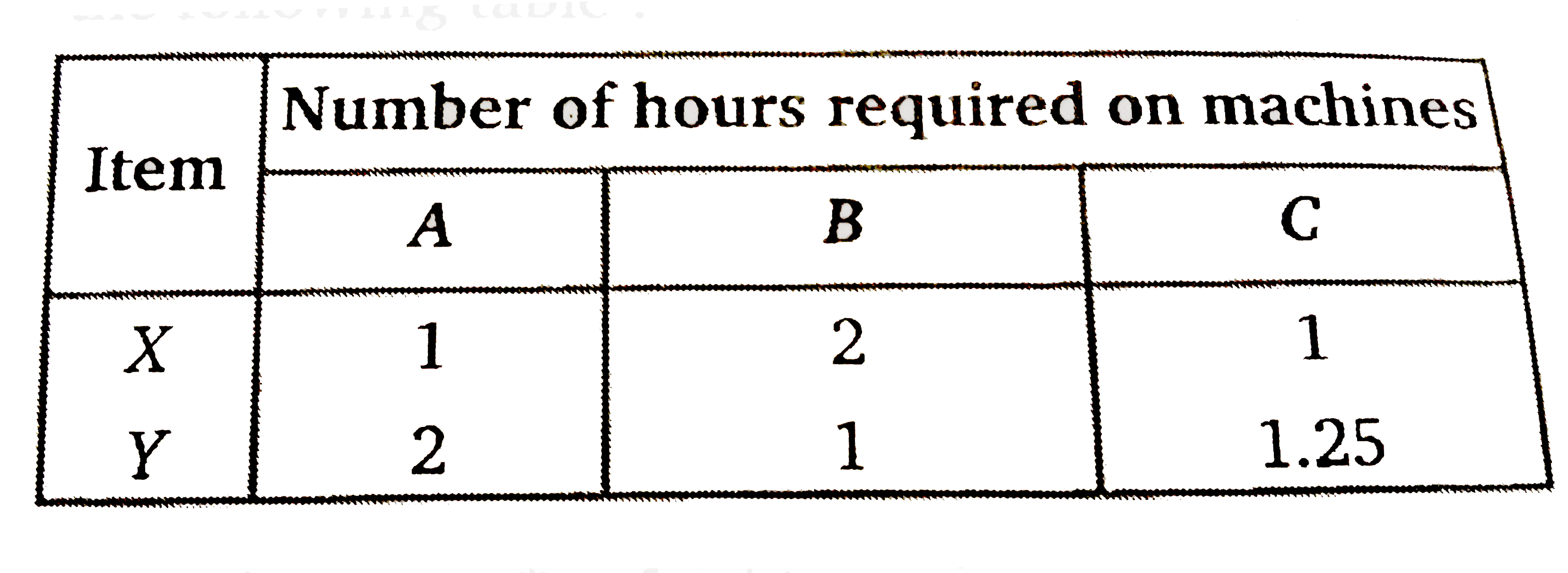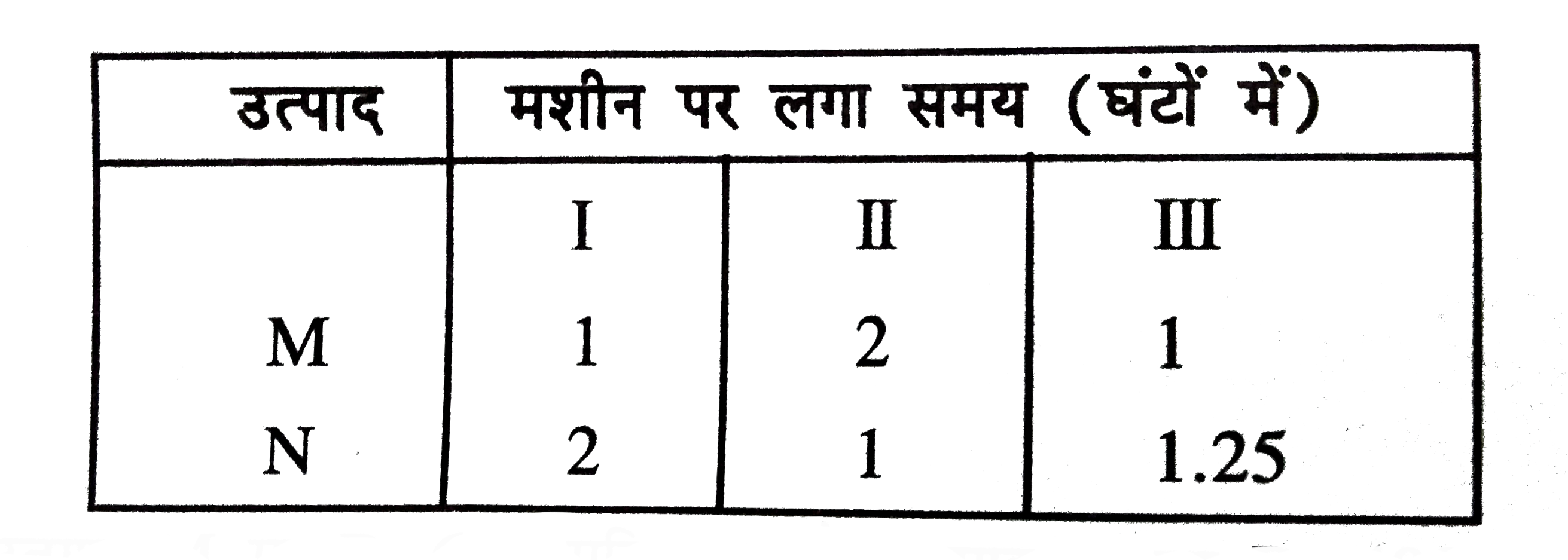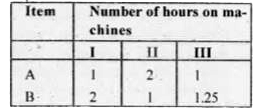(Manufacturing problem) A manufacturer has three machines I, II and III installed in his factory. Machines I and II are capable of being operated for at most 12 hours whereas machine III must be operated for atleast 5 hours a day. She produces only two items M and N each requiring the use of all the three machines. The number of hours required for producing 1 unit of each of M and N on the three machines are given in the following table :

She makes a profit of Rs. 600 and Rs. 400 on items M and N respectively. How many of each should she produce so as to maximise her profit assuming that she can sell all the items that she produced? What will be the maximum profit ?Solution in Gujrati
The correct Answer is:The manufacturer has to produce 4 units of each items. The maximum profit of Rs. 4000 will be at (4, 4).
Step by step video, text & image solution for (Manufacturing problem) A manufacturer has three machines I, II and III installed in his factory. Machines I and II are capable of being operated for at most 12 hours whereas machine III must be operated for atleast 5 hours a day. She produces only two items M and N each requiring the use of all the three machines. The number of hours required for producing 1 unit of each of M and N on the three machines are given in the following table : She makes a profit of Rs. 600 and Rs. 400 on items M and N respectively. How many of each should she produce so as to maximise her profit assuming that she can sell all the items that she produced? What will be the maximum profit ? by Maths experts to help you in doubts & scoring excellent marks in Class 12 exams.
Updated on:21/07/2023Topper's Solved these Questions
- LINEAR PROGRAMMINGBOOK - KUMAR PRAKASHANCHAPTER - LINEAR PROGRAMMINGEXERCISE - SOLUTIONS OF NCERT EXEMPLAR PROBLEMS
44 Videos
- LINEAR PROGRAMMINGBOOK - KUMAR PRAKASHANCHAPTER - LINEAR PROGRAMMINGEXERCISE - MULTIPLE CHOICE QUESTIONS
42 Videos
- LINEAR PROGRAMMINGBOOK - KUMAR PRAKASHANCHAPTER - LINEAR PROGRAMMINGEXERCISE - MISCELLANEOUS EXERCISE - 12
9 Videos
- INVERSE TRIGONOMETRIC FUNCTIONSBOOK - KUMAR PRAKASHANCHAPTER - INVERSE TRIGONOMETRIC FUNCTIONSEXERCISE - PRACTICE PAPER - 2 (SECTION - D)
2 Videos
- MATRICES BOOK - KUMAR PRAKASHANCHAPTER - MATRICES EXERCISE - Practice Paper - 3 (Section - D)
1 Videos
Similar Questions
Determine the maximum value of z = 11x + 7y subject to the constraints :
2x+y≤6,x≤2,x≥0,y≥0
View SolutionSolution set of the inequality 2x+y>5 is ………
View SolutionMaximize the function z=6x+3y , subject to the constraints : 4x+y≥80,x+5y≥115,3x+2y≤150,x≥0,y≥0
View SolutionProve that :
cot−1(√1+sinx+√1−sinx√1+sinx−√1−sinx)=x2,x∈(0,π4)
View SolutionFor matrix A=⎡⎢⎣11112−32−13⎤⎥⎦ . Prove that , A3−6A2+5A+11I=0. Hence find A−1 using it .
View Solution(Manufacturing problem) A manufacturer has three machines I, II and III installed in his factory. Machines I and II are capable of being operated for at most 12 hours whereas machine HI must be operated for atleast 5 hours a day. She produces only two items M and N each requiring the use of all the three machines. The number of hours required for producing 1 unit of each of M and N on the three machines are given m the following table:She makes a profit of Rs 600 and Rs 400 on items M and N respectively. How many of each item should she produce so as to maximise her profit assuming that she can sell all the items that she produced? What will be the maximum profit?
View SolutionA manufacturer produces nuts and bolts. It takes 1 hour of work on machine A and 3 hours on machine B to produce a package of nuts. It takes 3 hours on machine A and 1 hour on machine B to produce a package of bolts. He earns a profit of Rsl7.50 per package on nuts and Rs 7.00 per package on bolts. How many packages of each should be produced each day so as to maximise his profit, if he operates his machines for at the most 12 hours a day?
View SolutionA manufacturer has three machines A,B and C installed in his factory. Machines A and B are capable of being operated for atmost 12 hours whereas machine C must be operated for atleast 5 hours a day. He produces only two items X and Y each requiring the use of all the three machines. The number of hours required for producing 1 unit of each of X and Y on three machines are given in the following table:

He makes a profit of Rs. 600 and Rs. 400 on each item of X and Y respectively. How many of each item should he produce so as to maximize his profit assuming that he can sell all the items that he produced?
View SolutionA manufacturer produces nuts and bolts. It takes 1 hour of work on machine A and 3 hours on machine B to produce a package of nuts. It takes 3 hours on machine A and 1 hour on machine B to produce a package of bolts. He earns a profit of Rs. 17.50 per package on nuts and Rs. 7.00 per package on bolts. How many packages of each should be produced each day so as to maximise his profit, if he operates his machines for at the most 12 hours a day?
View SolutionA company manufactures bicycles and tricycles, each of which must be processed through two machines A and B. Machine A has maximum of 120 hours available and machine B has a maximum of 180 hours available. Manufacturing a bicycle requires 6 hours on machine A and 3 hours on machine B. Manufacturing a tricycle requires 4 hours on machine A and 10 hours on machine B.
If profits are ₹ 180 for a bicycle and ₹ 220 for a tricycle, determine the number of bicycles and tricycles that should be manufactured in order to maximize the profit.
View Solutionउत्पादन संबंधी समसया एक उत्पादन के कारखाने में तीन मशीनें I,II, III लगी हैं मशीनें I और II अधिकतम 12 घंटे तक चलाए जाने की क्षमता रखती है। जबकि मशीन III प्रतिदिन कम से कम 5 घंटे चलना चाहिनए। निर्माणकर्ता केवल दो प्रकार के सामान M और N का उत्पादन करता है जिनमें प्रत्येक के उत्पादन में तीनों मशीनों की आवश्यकता होती है। M और N के प्रत्येक उत्पाद के एक नग उत्पादन में तीनों मशीनों के संगत लगे समय (घंटों में) निम्नलिखित सारणी में दिए हैं।

वह उत्पाद M पर Rs. 600 प्रति नग और उत्पाद N पर Rs. 400 प्रति नग की दर से लाभ कमाती है। मानते हुए कि उसके सभी उत्पाद बिक जाते हैं जिनका उत्पादन किया गया है तब ज्ञात कीजिए कि प्रत्येक उत्पाद के कितने नगों का उत्पादन किया जाए, जिससे लाभ का अधिकतमीकरण हो? अधिकतम लाभ क्या होगा?
View SolutionA manufacturer has 3 machines I, II and III installed in his factory. Machines I and II are capable of being operated for utmost 12 hours whereas machine III must be operated atleast for 5 hours a day. He produces only two items A and B each requiring the use of three machines. The number of hours required for producing 1 unit of each of the items A and B on the three machines are given below.

He makes a profit of Rs 7600 on item A and Rs 400 on item B. Assume that he can sell all that he produces.
(i) Formulate this as a linear programming problem.
(ii) Solve the L.P.P by corner point method.
View Solution(Manufacturing problem): A manufacturer has three machines. I, II and III installed in his factory. Machines I and II are capable of being operated for at most 12 hours whereas machine III must be operated for atleast 5 hours a day. She produces only two items M and N each requiring the sue of all the three machines.
The number of hours required for producing 1 unit of each of M and N on the three machies are given in the follownig table:

She makes a profit of Rs. 600 and Rs. 400 on items M and N respectively. How many of each item should be produce so as to maximise her profit assuming that she can sell all the items that she produced? What will be the maximum profit?
View Solution(Manufacturing problem): A manufacturer has three machines. I, II and III installed in his factory. Machines I and II are capable of being operated for at most 12 hours whereas machine III must be operated for atleast 5 hours a day. She produces only two items M and N each requiring the sue of all the three machines.
The number of hours required for producing 1 unit of each of M and N on the three machies are given in the follownig table:

She makes a profit of Rs. 600 and Rs. 400 on items M and N respectively. How many of each item should be produce so as to maximise her profit assuming that she can sell all the items that she produced? What will be the maximum profit?
View SolutionA manufacturer produces nuts and bolts. It takes 1 hour of work on machine A and 3 hours on machine B to produce a package of nuts. It takes 3 hours on machine A and 1 hour on machine B to produce a package of bolts. He earns a profit of Rs 17.50 per package on nuts and Rs 7.00 per package on bolts. How many packages of each should be produced each day so as to maximise his profit, if he operates his machine for at most 12 hours a day?
View Solution
